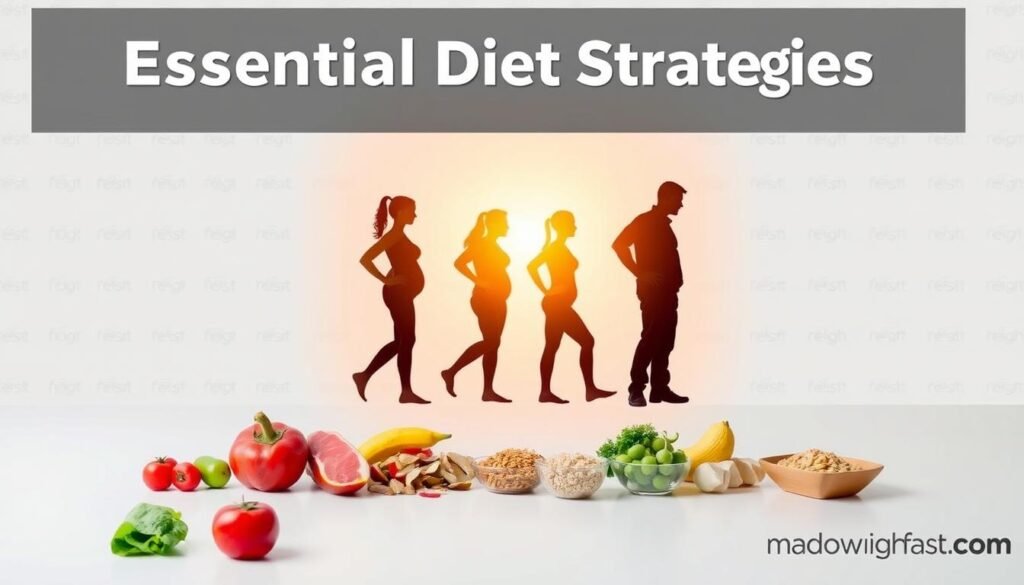Rapid Weight Loss in the USA: Tips and Strategies
Ever wonder why so many Americans chase quick fixes for managing their size? While fast results might seem appealing, there’s more to dropping extra pounds than crash diets or extreme measures. Let’s explore what actually works—and what could backfire—when aiming for noticeable changes.
Health experts define accelerated programs as losing over 2 pounds weekly for multiple weeks. These approaches often involve strict calorie limits and require close medical oversight. Though popular, studies show most individuals regain what they lose through drastic methods compared to gradual, sustainable habits.
Why does this matter? Understanding your starting point and overall health is crucial before attempting any intense regimen. Professionals emphasize personalized plans over one-size-fits-all solutions, especially since everyone’s body responds differently to dietary shifts.
You’ll also discover how cultural pressures and instant-gratification mindsets influence choices. Balancing ambition with realistic expectations helps create lasting success. Let’s break down the smart way to approach your goals without compromising well-being.
Key Takeaways
- Accelerated programs require medical supervision to ensure safety
- Gradual changes often lead to more sustainable outcomes
- Personal health factors determine suitability for intense regimens
- Cultural trends heavily influence diet choices nationwide
- Realistic timelines prevent frustration and burnout
- Professional guidance improves long-term success rates
Understanding Rapid Weight Loss in the United States of America
Dropping pounds fast can trigger unexpected reactions in your system. While quick results might tempt you, your biology has built-in responses that demand careful consideration.
What Counts as Fast Progress?
Medical professionals define accelerated programs as shedding over 2 pounds weekly for multiple weeks. This approach typically involves consuming fewer than 1,200 calories daily and requires professional monitoring. Why the strict limits? Your systems interpret severe cuts as survival threats, activating protective mechanisms.
| Factor | Accelerated Approach | Gradual Method |
|---|---|---|
| Weekly Loss Rate | 2+ lbs | 1-2 lbs |
| Muscle Retention | Lower | Higher |
| Hormonal Impact | Intense | Mild |
| Sustainability | Short-term | Long-term |
Your System’s Survival Mode
When you slash calories drastically, your body prioritizes energy conservation. It burns both fat and muscle tissue, which slows your metabolism. This explains why many people hit plateaus or regain pounds after stopping strict diets.
Hunger hormones like ghrelin spike during fast transformations, making cravings harder to resist. Your brain also fights to return to previous body weight levels through set point mechanisms. Balancing speed with biological realities helps maintain results without compromising health.
Essential Diet Strategies for Fast Results
Choosing the right nutritional approach can make or break your progress. Let’s compare two popular methods and explore how timing your meals might boost outcomes.

Very Low-Calorie Diets vs. Low-Calorie Diets
VLCDs slash intake to 800 calories daily, often using shakes or soups instead of meals. “These programs demand medical supervision,” notes a Johns Hopkins study, “but may drop 3-5 pounds weekly.” LCDs offer more flexibility—1,200-1,800 calories depending on gender—while still creating deficits.
While VLCDs deliver quick changes, they risk muscle loss and fatigue. LCDs balance faster results with manageable hunger. Our structured meal plan adapts LCD principles for safer implementation.
Intermittent Fasting and Time-Restricted Eating
The 16:8 method limits eating to 8 daytime hours. Research shows this pattern helps reduce calorie intake naturally. Your body taps into fat stores during fasting periods, though results vary by individual.
Key advantages? No strict calorie counting. Challenges include managing evening cravings. Start with 12-hour fasts, gradually extending the window. Pair this strategy with nutrient-dense meals to maintain energy levels throughout the day.
Balancing Exercise and Physical Activity for Optimal Health
Moving your body smartly can make all the difference when reshaping your physique. While cutting calories drives most changes, pairing it with thoughtful movement helps maintain energy and health.

Incorporating Strength Training
Lifting weights 2-3 times weekly protects lean tissue while burning fat. Why does this matter? Extreme calorie cuts often eat away muscle—strength sessions signal your body to preserve it. Start with bodyweight exercises like squats before adding resistance.
| Activity Type | Weekly Frequency | Key Benefit |
|---|---|---|
| Strength Training | 2-3 sessions | Muscle retention |
| Brisk Walking | 5 days | Heart health |
| Yoga | 1-2 sessions | Recovery support |
Avoiding Overtraining Pitfalls
Pushing too hard? Watch for constant soreness or irritability. Your body needs rest days to rebuild. Alternate intense workouts with light activities like swimming.
Balance matters most. Pair movement with a structured approach to nutrition for lasting results without burnout. Listen to your energy levels—scale back if you feel dizzy or exhausted.
Managing Side Effects and Understanding Health Risks
Your body sends signals when changes happen too quickly. Extreme calorie cuts might lead to unexpected challenges, from headaches to digestive troubles. Learning to spot these warnings helps you adjust your approach before minor issues become serious.
Fuel Shortages and Fluid Imbalances
Drastic calorie reductions often leave your system scrambling for nutrients. Common signs include brittle nails, hair thinning, and constant tiredness. Dehydration sneaks up faster than you’d expect—dry mouth and dark urine mean it’s time to up your water intake.
| Symptom | Possible Cause | Action |
|---|---|---|
| Muscle cramps | Electrolyte imbalance | Add sodium/potassium-rich foods |
| Constipation | Low fiber intake | Increase vegetables gradually |
| Dizziness | Dehydration | Drink 8 oz water hourly |
A recent study found 78% of extreme dieters develop vitamin deficiencies. Pair any intense program with multivitamins and regular blood tests.
Gallbladder Stress and Gut Reactions
Your liver works overtime during drastic changes, increasing gallstone risks. Sharp pains under your ribs? That could signal trouble. Gradually reducing portion sizes helps prevent this issue.
Digestive systems rebel against sudden shifts. Bloating often comes from artificial sweeteners in diet products. Swap processed shakes for whole foods to ease discomfort. If symptoms last over 72 hours, consult your doctor.
Remember:Temporary water reduction isn’t true progress. Focus on lasting changes that keep your energy steady and body functioning properly.
Debunking Myths about Crash Diets and Quick Fixes
The diet industry thrives on promises that seem too good to be true—because they usually are. Let’s separate fact from fiction and explore why shortcuts often lead to dead ends.
The Truth About Diet Pills and Overhyped Claims
Many supplements promise effortless changes, but studies reveal troubling patterns. Diet pills frequently contain unregulated stimulants that spike heart rates and disrupt sleep. Remember ephedra? This once-popular ingredient caused strokes before the FDA banned it—yet similar compounds still lurk in modern products.
“Quick-fix solutions often trade short-term gains for long-term health risks.”
Crash diets trigger your body’s survival instincts. When you slash calories too hard, your metabolism downshifts to conserve energy. This biological brake explains why most people regain pounds—plus extra—after extreme plans.
| Factor | Diet Pills | Sustainable Methods |
|---|---|---|
| Results Timeline | 1-2 weeks | 3-6 months |
| Health Risks | High | Low |
| Long-Term Success | 12% | 68% |
| Metabolism Impact | Damaging | Neutral |
Why do these methods stay popular? Psychological factors like impatience and social pressure make magic solutions appealing. Instead, focus on gradual dietary shifts paired with professional guidance. Your body—and sanity—will thank you later.
Developing a Sustainable Eating Plan
Creating lasting change starts with rethinking your plate. Instead of temporary restrictions, focus on building habits that fuel your body while keeping meals enjoyable. This shift helps maintain progress without feeling deprived.
Meal Planning for Long-Term Success
Start with simple weekly templates that mix proteins, veggies, and smart carbs. Batch-cooking staples like grilled chicken or quinoa saves time while ensuring balanced options are always available. Keep snack bags of nuts or sliced veggies handy for hunger emergencies.
Portion awareness beats strict counting. Use your palm as a protein guide and fill half your plate with colorful produce. This method maintains calorie control while letting you enjoy meals socially.
Incorporate nutrient-packed foods like eggs, spinach, and berries to support energy levels. These choices help repair your system after intense programs while keeping cravings manageable. Allow occasional treats—deprivation often backfires.
Gradual adjustments stick better than overnight overhauls. Swap soda for sparkling water first, then tackle other changes weekly. Small wins build confidence for lasting transformations that become second nature.
FAQ
How can I shed pounds safely without extreme dieting?
Focus on balanced meals with lean proteins, whole grains, and veggies. Pair this with regular movement like walking or yoga. Avoid cutting calories too low, as it can slow your metabolism and lead to muscle loss.
What’s the difference between very low-calorie and low-calorie plans?
Very low-calorie diets (under 800 calories/day) require medical supervision and are short-term. Low-calorie plans (1,200–1,500 calories) offer more flexibility but still need careful nutrient tracking to avoid deficiencies.
Can intermittent fasting help me reach my goals faster?
Time-restricted eating, like the 16:8 method, may support fat burning by aligning with your body’s natural rhythms. However, results vary—pair it with quality foods and avoid overeating during non-fasting windows.
Why is strength training important when adjusting my routine?
Lifting weights preserves lean mass, which keeps your metabolism active. Without it, you might lose muscle instead of fat, making it harder to maintain progress long-term.
How do I know if I’m overdoing workouts?
Signs include constant fatigue, irritability, or trouble sleeping. Balance cardio with rest days and listen to your body—recovery is just as vital as effort.
What are red flags for nutrient shortages during dietary changes?
Brittle nails, hair thinning, or dizziness may signal low iron, vitamins, or electrolytes. Stay hydrated and consider a multivitamin if your meals lack variety.
Are diet pills a reliable shortcut for quick results?
Most supplements lack strong evidence and may cause jitters or digestive trouble. Prioritize whole foods and consult a healthcare pro before trying any pills.
How can meal prep support lasting habits?
Planning meals reduces impulsive choices and ensures you have nourishing options ready. Start with simple recipes and adjust portions based on your energy needs.
Can drastic changes lead to gallstones or digestion problems?
Yes—sudden drops in calorie intake may disrupt bile production, raising gallstone risks. Gradual adjustments and including healthy fats like avocado can help prevent issues.
What’s the best way to keep energy up while making changes?
Eat small, frequent meals rich in fiber and protein. Stay hydrated with water or herbal teas, and limit sugary snacks that cause energy crashes.


